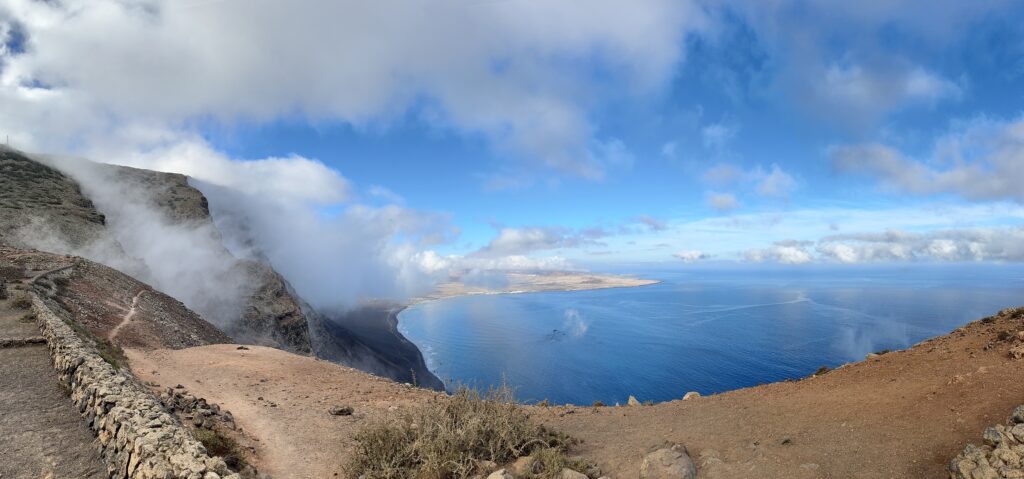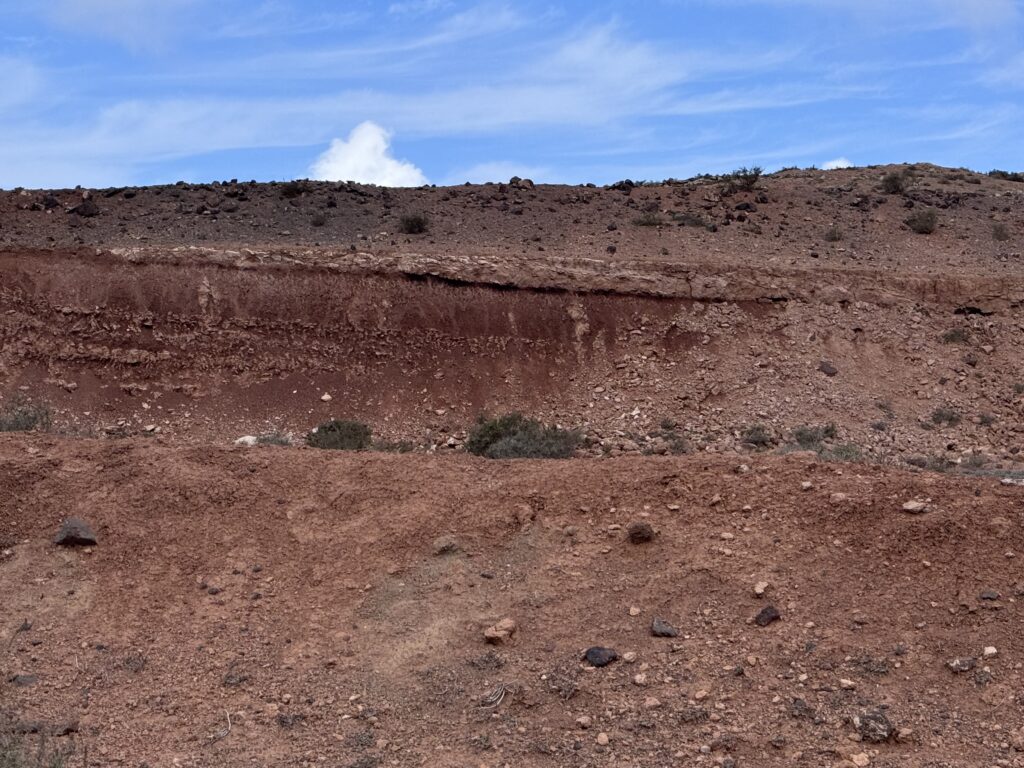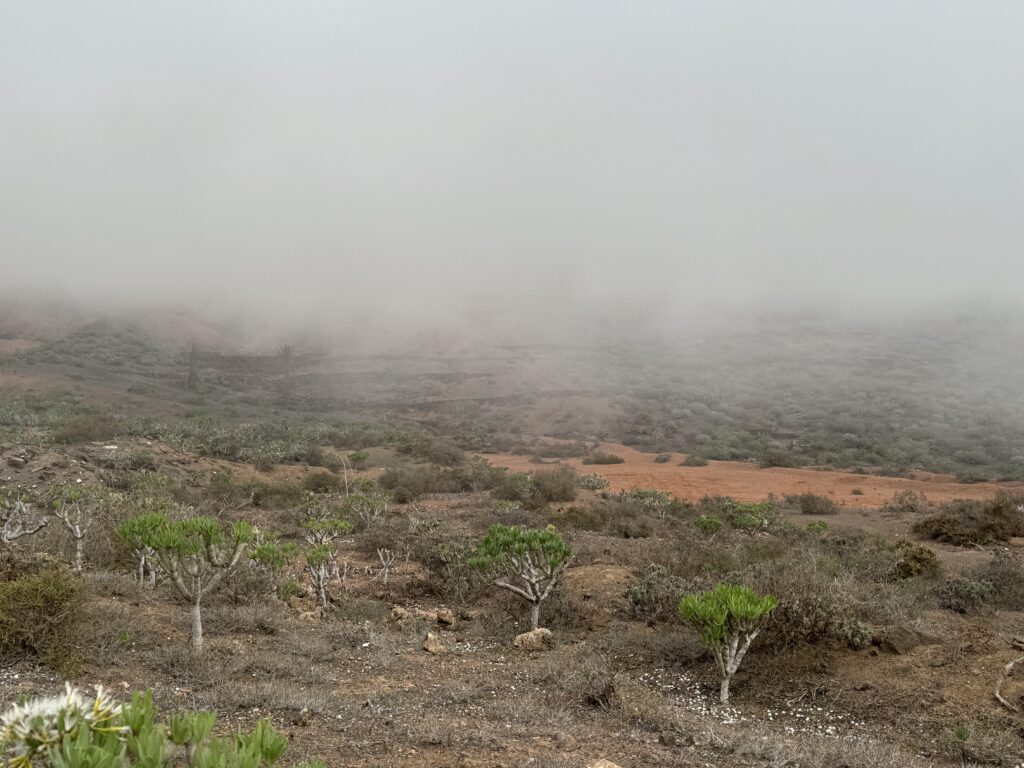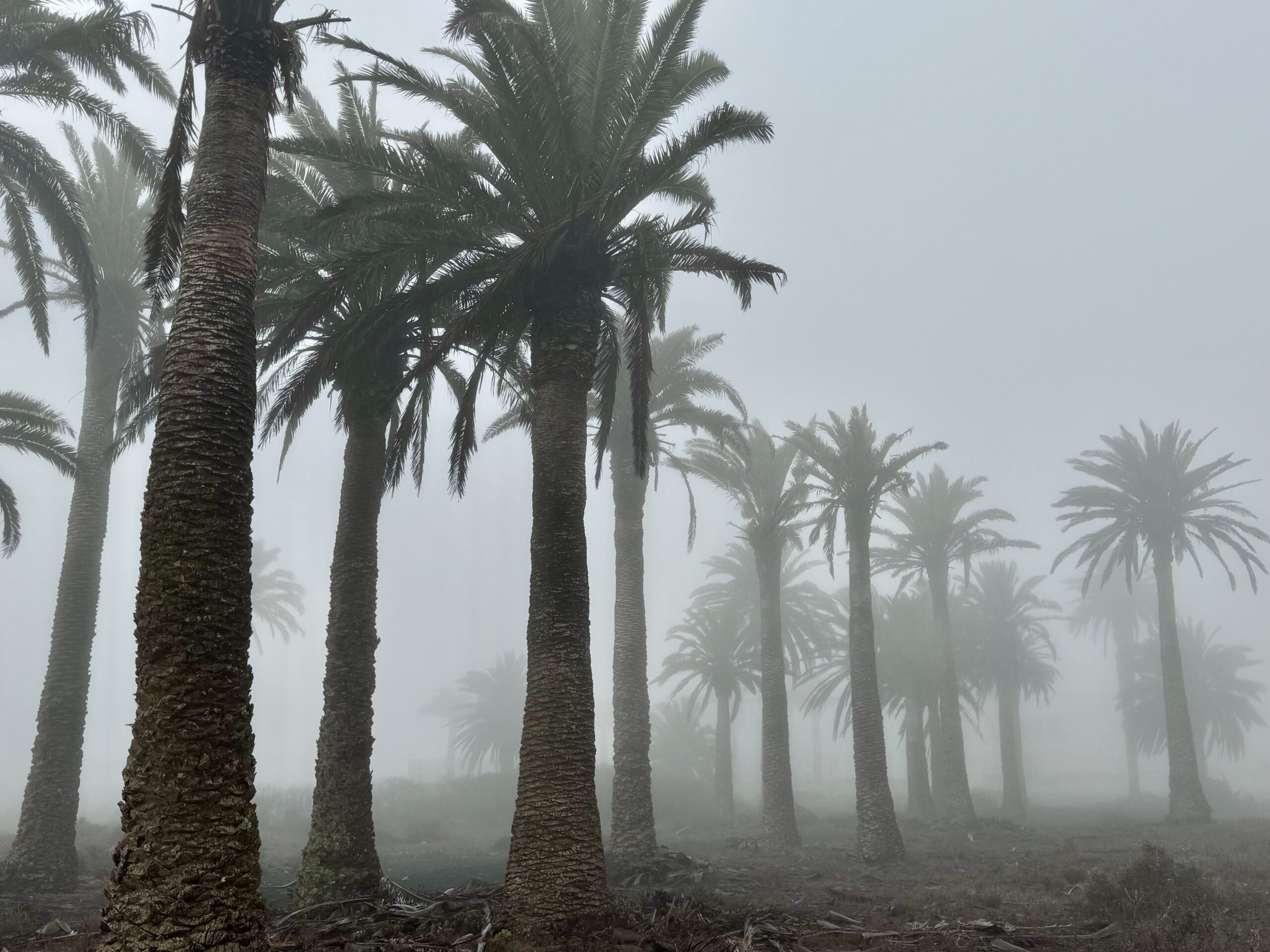Lanzarote is known for its year-round warm, sunny climate, and is indeed a true desert island when measured on the Köppen climate classification scale due to extremely low levels of precipitation. However, like most of the archipelago, if positioned favourably within the unique topography of each island, certain regions of high ground can become considerably foggy for long periods of time. One such place is Haría’s Mt. Aganada, where fog can accumulate for at least six months of the year. And where there are clouds, there can be forests.

Cloud Forests
They sound like something from the Lord of the Rings but these delicate ecosystems are very real and nearer than you might think. A cloud forest exists where rolling cloud passes over hilltops and, although little or no rain is deposited the tiny water droplets which form the cloud are intercepted by leaves and branches of the trees and drip down into the soil, watering roots. In Tenerife, for example, the pine forest intercepts cloud in this way, providing several times more ground water than the island gets from rainfall. The magnificent Tenerife forest is certainly not elfin, it forms a ring which does not reach the peak of Mt. Teide and is consequently protected from the worst of the wind. Elfin forests exist on hilltops and lack this protection, therefore trees tend to be stunted and bent by constant gales. Such a forest existed on the highest parts Haría district until a century or two ago, now only a handful of trees remain but the thickness of topsoil proves without doubt that such a forest existed there until fairly recently. There were no pines as these are not native to Lanzarote, but instead trees such as the acebuche, a relative of the cultivated olive, formed a forest ecosystem known as Laurisilva . Despite its aridity Lanzarote may have more unique plants than any other Canary Island, most of which are native to this region, if trees could be re-established other native flora and fauna can be expected to follow, an ecosystem of great biological importance would be resurrected. A splendid goal in a century becoming increasingly characterised by wholesale destruction of such delicate ecosystems!


If you take a walk along Haría’s Mt. Aganada when cloud cover is present (take care not to get lost!) you will notice that the cloud hovers a metre or so above the ground – your hair gets damp while your legs remain dry. This illustrates the problem that reforestation schemes have so far met, until a tree grows big enough it cannot access water from passing clouds. Young trees have been planted in their thousands, most have dried up and died. A simple but effective method of nurturing treelings can be implemented. Placing large nets supported high above the ground and positioned so as to intercept passing clouds, liberates hundreds of litres of pure water used to feed tree roots until they grow tall enough to take over from the nets, effectively kick-starting development of a new forest. https://fogquest.org website (available in both English and Spanish) provides the most up-to-date guide to modern fog capturing projects and techniques.
I put together a project plan involving planting native trees using simple cloud catching nets on the sumit of Montaña Aganada, after seeking advice from Professor Schemenauer, a pioneer in this type of project, and also citing the work of Professor Victoria Marzol, from Tenerife’s University of La Laguna.
The project was submitted for funding to the Island Council in October 2003, by Haría council, and approved. The full project can be viewed here.
The pilot project ran successfully from the summer of 2004. Articles about the project were featured in the media.
A particularly strong tropical depression (Storm Delta) destroyed the nets in the winter of 2005. What followed was a political dispute, whereby the council accused me of plagiarism and took over the project. I was forbidden to participate in its future development, and tragically the council later abandoned the project. Twenty years on, there could now be a significant forest at Montaña Aganada, but the site remains a desert plateau. It continues to be cloaked with clouds, and occasionally heavily eroded by rains. It is a ghost forest, one of the imagination, waiting to be brought back to life.
A detailed review of the council takeover in Diario de Lanzarote in 2016 with English translation can be found here.
The letter below affirms my position as the original author of the project:
I love trees and have spent much of the last 20 years cultivating some of our rare native flora in my garden, I am therefore very interested to see that Torres Stinga, the Mayor of Haria and his political associate Juan Manuel Gonzalez have not only implemented this project but have also presented it to the Biosphere department on the 11th of August when it won an award for sustainable projects.
Just one little problem bothers me, how is this work, presented as his own by Snr. Gonzalez, any different from the proposal I wrote up on the request of the Mayor and shown to him in 2003? My original proposal has been available since then for all to see on my website, harialanzarote.com . At first the years of work I put into the scheme were acknowledged , newspaper reports called the pilot scheme ‘Projecto David’. But when I started to talk about sources of funding for phase 2 of the project Snr. Gonzalez became very cagy, refusing to give me any access to his accounts claiming that I had no right to ask about finances for the scheme because ‘it had nothing to do with me’ in fact, he said, I had merely plagiarised the work from another scientist. If you look at the proposal on my website you can see that I mention a Canarian Scientist, Professora Marzol, as a possible source of collaboration, indeed I had been in communication with her many years before as she has experience with cloud interception as a source of drinking water. She tells me she is most surprised to be used as an excuse for removing the project from my involvement. If my work was in fact stolen from her it would seem most unlikely that I would name her in my proposal!
Mine was the first proposal to use cloud catching techniques to restore the Haria cloud forest. In fact, the thesis outlining the project which I prepared for my MSc degree in environmental forestry, available from the library of the University of North Wales (or from me!). seems to be the first suggest that the then recently developed cloud capture nets could be used for reforestation rather than just drinking water. My thesis written and accepted in 1993, many years before I persuaded the mayor that my project was feasible and he asked me to prepare the project proposal.
For a long time the mayor continued to give me false assurances, when I asked him to confirm that the years of scientific study I had put into the project would not be wasted, but it became clear that the suggestion that I had stolen the project from Prof. Marzol was being circulated among councillors, so I prepared a copy of some documents proving my original authorship and left copies at the ayuntamiento for every member of the council. The mayor prevented these from being passed on and at the same time stopped pretending to have any sympathy for my situation.
Shortly after this disappointment a chain of officials started turning up at my house saying that I had ‘stolen’ a couple of metres of baranco when I repaired a wall and had to pay thousands of euros to put things right. The whole case was ridiculous and was eventually thrown out of court, but not before costing me a lot of time and worry. Of course it is probably ridiculous to suspect that this problem was a warning to me from the mayor not to rock the boat for his friend. But when I contrast the enormous trouble about that wall with the apparent total absence of action over entire buildings that are illegally springing up like mushrooms all over Haria, I can’t help but wonder if the mayor isn’t capable of using his power to both punish and reward.
Since the mayor now refuses to see me and JM has broken his promise to keep me informed of developments I would like to present the following open letter to them both;
JM you have shamelessly stolen my project, pretending expertise you lack. You have added insult to injury by suggesting that it is was not my original idea in the first place. If you say that ‘your’ project involves doing anything significant other than following the instructions as written in my original proposal then you are a liar.
Snr Mayor, I trusted you with my project as a collaboration. You have taken it without my permission using it to reward your political associate, a one time insurance salesman who had never grown a tree in his life. If you gain control of the Cueva and Jameos as you intend, will it be to the advantage of those who have worked selflessly for the benefit of Haria district it or only your fellow members of the Coalicion Canarias? It is ironic that you launched your career as mayor with a vitriolic attack criticising the lack of honesty of Snr. Ramirez, the previous mayor (now ‘rehabilitated’ as a fellow member of the Coalition Canarias). Whatever Ramirez was guilty of, it probably only involved money – you however have stolen years of my life.


